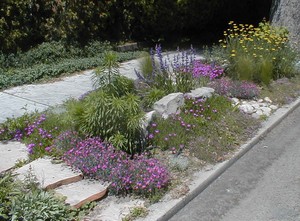Water conservation is a subject that has many people talking. As our population grows, our natural water resources are feeling the strain. Certain parts of the country, especially in the south west, are already feeling the impact of limited water resources.
Low water gardening is an alternative way of gardening that reduces water use. Low water gardening, also called Xeriscape landscaping, doesn’t mean ripping out your lawn and replacing it with gravel and cactus. Instead, it refers to applying low water principles in your landscape plan. To lower your water use, choosing low water plants, using wood chips in your beds to reduce evaporation, adding compost to your soil to improve water capacity, and using sensible watering practices.
A great place to plant a low water garden are along sidewalks or in the public areas, called “parkways”. These are the patches of ground located between the sidewalk and curb in front of your home. The intense heat these areas receive from the asphalt are perfect locations for a low water and heat tolerant garden.
The first step is preparing the space, and getting rid of existing grass and weeds. An organic approach, is covering the spot with black visquine and let the vegetation die on it’s own. A non-organic method is spraying the area with Round-Up. Be sure you follow the instructions for application.
After the weeds and grass have died, take a look at the composition of your soil. It is rock hard or sandy? Full of clay? If the answer is “yes,” you will have to improve the soil before planting. For soil that is hard, give the ground a good soaking to soften up the dirt. I usually turn our beds with a shovel, but if the ground is unworkable, you might consider renting a rototiller. Once the soil has been turned, you can begin steps to improve it. If you are new to gardening, take a soil sample to your local nursery (not a Big Box store!) and ask for advice. I usually add a combination of manure, compost, and peat moss to my beds. A local garden shop might also suggest additional materials, such as sand or gypsum to improve the soil. Mix the material in a wheel barrow and distribute evenly over the turned soil. Using a shovel or pitchfork, turn the soil over once more time, working the mixture into the ground. Level with a rake.
Drawing your landscape plan
One of my favorite idea resources is High Country Gardens (www.highcountrygardens.com) which specializes in low water plants for Western gardens. Their on line catalogue is full of helpful information, color photographs, and great low water gardening ideas. Gardening books specific for your planting zone are also good resources. Your local county extension officer can also help.
Using these resources, draw up a landscape plan on sheets of grid paper, using colored pencils and a compass. This will help you draw up a color combination that’s pleasing to the eye, and lets you plot out how much space is needed in between the plants. Many low water garden plants reach their full size in a year; if they are planted them too close, you’ll find yourself removing half your plants the following spring.
Things to consider when planning low water planting beds are color combinations and height. Higher plants should be placed in the middle, with mid sized plants surrounding them. Place low plants along the sidewalk edge. For curbside, “walkable plants” are an excellent choice. These plants that can take the abuse of being walked on by motorists who park their cars along the garden. Also keep the blooming season in mind. It is best to choose from a mix of early flowering varieties, mid summer, and early fall. This way, something is always in bloom
A final thing to watch for is that all the plants have identical watering needs. A plant that needs moist soil and shade is not compatible with a plant that only needs water once every 2 weeks. By grouping low water plants together, you will make the best possible use of those times you do water.
Where to buy your plants
Once you have an idea of the type of plants you want, it’s time to visit your local nursery. If you are new to low water gardening, you might want to visit a greenhouse instead of buying your plants at a discount mart. You’ll need the experience of the nursery staff to learn which plants are hardy for your planting zone. They will even guide you as to proper planting techniques. I discovered that many of the varieties of the plants I had picked from my resource books weren’t available in our area. The staff was able to suggest different varieties of the same species. There were certain plants that I really wanted but couldn’t find locally. These were ordered from High Country Gardens.
Using a yard stick, and referring to your map, begin setting the potted plants in place.
With the soil already prepared, you simply dig a hole with a hand trowel and sprinkle in a handful of manure. Carefully tip the plants out of the pot, break up the root ball, and plant directly in the ground.
How to water efficiently
The final step in building your garden, is deciding on a watering system. The most efficient way of watering any bed is with a soaker hose. Soaker hoses get water to the root of the plant, without evaporating into the air like a standard sprinkler. They work well with overnight waterings set at a slow speed. Watered in this fashion, you’ll discover your water usage drops considerably.
As you lay the hoses down, keep them level as possible. A “Y” attachment can join the two hoses to simplify waterings. To keep the hoses in place, make garden hooks out of old clothes hangers which have been cut into 8″ lengths, with a hook bent into one end. Once the hoses are in place, cover the entire bed with a layer of wood bark or chip. The mulch will help retain moisture in the soil and reduces the growth of weeds.
Your new bed will need frequent watering until the roots are firmly established, at least for a couple of months. As the plants begin to grow, you can gradually cut back on the amount of water. Even though I live in a very arid, desert-like climate, my street gardens only require water every 2 weeks.







